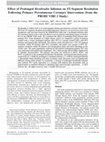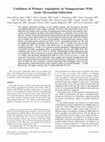Papers by Sara De Matteis

Acta Obstetricia Et Gynecologica Scandinavica, 2009
Estimates of endometriosis recurrence after primary surgery are around 10% per annum during the f... more Estimates of endometriosis recurrence after primary surgery are around 10% per annum during the first postoperative quinquennium. The aim of this study was to define the effect of reoperation in women seeking conception. A MEDLINE and PubMed search was conducted to identify English language studies published in the last 30 years evaluating reproductive performance after second-line surgery. Repeat surgery for recurrent endometriosis and identification of women seeking pregnancy were selected. Two authors abstracted data on standardized forms. The initial literature screening yielded 41 citations, but 19 were excluded because no data on reoperation were described, seven as no original figures were included, three because analyses were performed on the same cohort, and one because extremely skewed data were reported. A total of 313 patients who sought pregnancy after repetitive surgery for recurrent endometriosis were found, 139 in six non-comparative studies, and 174 in five retrospective comparative studies. Overall, pregnancy was achieved in 81 women (26%; 95% confidence interval (CI), 21-31%), without significant difference between the laparotomy (27%) and laparoscopy (25%) approach. Three studies compared pregnancy rate after second-line (28/124; 23%) and primary surgery (236/577; 41%; common odds ratio (OR), 0.44; 95% CI, 0.28-0.68%), and two compared the probability of conception after in-vitro fertilization (IVF) (14/27; 30%) and repetitive surgery (10/50; 20%; common OR, 1.51; 95% CI, 0.58-3.91%). Conclusions. The probability of conception after repeat surgery for recurrent endometriosis appeared limited and reduced compared with that after primary surgery. The results of IVF were not inferior to those of reoperation.
Reproductive Biomedicine Online, 2010
Paolo Vercellini is an Associate Professor of Obstetrics and Gynaecology at the University of Mil... more Paolo Vercellini is an Associate Professor of Obstetrics and Gynaecology at the University of Milan and Chief of the Benign Gynaecological Surgery Service of the Department of Obstetrics and Gynaecology of the Luigi Mangiagalli Institute of Milan, Italy. His research focuses on the pathogenesis and treatment of endometriosis, medical and surgical therapies for uterine leiomyomas, the pathogenesis of chronic pelvic pain, diagnosis and therapy of menorrhagia, and reproductive surgery. He is a reviewer for many international journals, is author or co-author of over 200 peer-reviewed scientific articles and has contributed numerous book chapters.
PLOS One, 2009
Background: Chronic obstructive pulmonary disease (COPD) has been consistently associated with in... more Background: Chronic obstructive pulmonary disease (COPD) has been consistently associated with increased risk of lung cancer. However, previous studies have had limited ability to determine whether the association is due to smoking.

International Journal of Cardiology
Background: We tested drug-eluting stent (DES) and bare metal stent (BMS) performance in small co... more Background: We tested drug-eluting stent (DES) and bare metal stent (BMS) performance in small coronary vessels by means of meta-analysis of all available clinical studies. Methods: The analysis included randomised controlled trials (RCT), subgroups of RCT and observational studies with a follow-up of at least six months comparing the use of DES and BMS during percutaneous interventions involving small coronary arteries (diameter b 3 mm). The primary endpoint was target vessel failure (TVF); the others were pooled and isolated major adverse cardiovascular events (MACE), stent thrombosis (ST), binary restenosis and late lumen loss at the longest available follow-up. The effect of treatment was evaluated in terms of odds ratios (OR) and 95% confidence intervals (95% CI) for binary variables, and mean difference (MD) ± standard deviation (SD) for continuous variables. Fixed-or randomeffect models were used depending on the statistical heterogeneity of studies. The analyses of major endpoints were stratified by study type, length of follow-up, and type of DES. Results: We pooled 12 studies involving 3182 patients. Trial heterogeneity was a minor issue. TVF (OR: 0.35; CI: 0.24-0.51), MACE (OR: 0.36; CI: 0.29-0.45), binary restenosis (OR: 0.15; CI: 0.12-0.20) and late lumen loss (MD: − 0.46; SD: − 0.55 to −0.38) all significantly improved with DES treatment; ST (OR: 0.63; CI: 0.34-1.17) was not statistically different between studies.

The authors examined the relation between occupation and lung cancer in the large, populationbase... more The authors examined the relation between occupation and lung cancer in the large, populationbased Environment And Genetics in Lung cancer Etiology (EAGLE) case-control study. in the Lombardy region of northern Italy, 2,100 incident lung cancer cases and 2,120 randomly selected population controls were enrolled. Lifetime occupational histories (industry and job title) were coded by using standard international classifications and were translated into occupations known (list A) or suspected (list B) to be associated with lung cancer. Smoking-adjusted odds ratios and 95% confidence intervals were calculated with logistic regression. For men, an increased risk was found for list A (177 exposed cases and 100 controls; odds ratio ¼ 1.74, 95% confidence interval: 1.27, 2.38) and most occupations therein. No overall excess was found for list B with the exception of filling station attendants and bus and truck drivers (men) and launderers and dry cleaners (women). The authors estimated that 4.9% (95% confidence interval: 2.0, 7.8) of lung cancers in men were attributable to occupation. Among those in other occupations, risk excesses were found for metal workers, barbers and hairdressers, and other motor vehicle drivers. These results indicate that past exposure to occupational carcinogens remains an important determinant of lung cancer occurrence.

American Journal of Cardiology, 2011
Bivalirudin is widely used as an anticoagulant during percutaneous coronary intervention (PCI) fo... more Bivalirudin is widely used as an anticoagulant during percutaneous coronary intervention (PCI) for ST-segment elevation myocardial infarction. However, an increase in acute stent thrombosis rates has been found in the HORIZONS-AMI trial. A prolonged infusion after PCI has been shown to be a safe and effective tool in patients undergoing urgent or elective PCI in the PROBI VIRI study. We examined the effects of prolonged drug infusion after primary PCI. From databases of 5 high-volume centers we compared a group of patients treated with a 4-hour prolonged infusion after PCI to 2 groups treated with a peri-PCI infusion and heparin plus abciximab. The primary study end point was >70% ST-segment resolution within 90 minutes after PCI; secondary end points were partial (>50%) STsegment resolution within 90 minutes and intrahospital major and minor bleedings on the Acuity scale. The study population consisted of 264 patients undergoing primary PCI who were pretreated with aspirin and clopidogrel. The 3 study groups did not differ significantly by baseline characteristics. The primary end point was achieved in 69.8%, 48.8%, and 69.6% of patients in the prolonged bivalirudin, bivalirudin, and heparin/abciximab groups, respectively (p ؍ 0.048 for prolonged vs standard infusion, p ؍ 0.98 for prolonged infusion vs abciximab). Major bleedings and other secondary study end points were not significantly different among study groups. In conclusion, a strategy of prolonged bivalirudin infusion after primary PCI seems equivalent to a strategy with heparin plus abciximab, with an improvement in standard infusion in obtaining early microvascular reperfusion.
American Journal of Epidemiology, 2010
The authors examined the relation between occupation and lung cancer in the large, population-bas... more The authors examined the relation between occupation and lung cancer in the large, population-based Environment And Genetics in Lung cancer Etiology (EAGLE) case-control study. in the Lombardy region of northern Italy, 2,100 incident lung cancer cases and 2,120 randomly selected population controls were enrolled. Lifetime occupational histories (industry and job title) were coded by using standard international classifications and were translated into occupations known (list A) or suspected (list B) to be associated with lung cancer.

American Journal of Cardiology, 2010
The optimal reperfusion strategy in very elderly patients with ST-segment elevation myocardial in... more The optimal reperfusion strategy in very elderly patients with ST-segment elevation myocardial infarction is still a subject of debate. The aim of this multicenter study was to determine the medium-term outcomes of nonagenarians after primary percutaneous intervention for ST-segment elevation myocardial infarction. A systematic review of the databases of 7 Italian centers showed that these had performed 5,023 primary angioplasties over the previous 5 years, 100 of which (2%) involved patients >90 years old. Thirty-five subjects were in Killip class III or IV at time of presentation, 78 had multivessel coronary artery disease, and mean ejection fraction was 0.40 ؎ 0.12%. In-hospital mortality was 19% and was significantly higher in patients with shock (58% vs 10%, p <0.001). Survival rate after 6 months was 68%: 16% in those with Killip class IV at admission and 81% in the remaining patients (p <0.001). Cox regression analysis identified 3 independent predictors of 6-month mortality: cardiogenic shock at presentation (hazard ratio [HR] 10.82, 95% confidence interval [CI] 4.51 to 25.93, p <0.001), Thrombolysis In Myocardial Infarction myocardial flow after percutaneous coronary intervention (HR 0.19, 95% CI 0.07 to 0.50, p ؍ 0.001), and abciximab administration (HR 0.32, 95% CI 0.13 to 0.78, p ؍ 0.01). In conclusion, the results of this multicenter study suggest that selected nonagenarians with acute myocardial infarction benefit from successful primary angioplasty. The treatment does not affect the poor prognosis of patients presenting with cardiogenic shock, but the administration of abciximab seems to have a positive effect on 6-month mortality.

Annals of Medicine, 2009
Although clinically different, celiac sprue and inflammatory bowel disease are characterized by c... more Although clinically different, celiac sprue and inflammatory bowel disease are characterized by chronic intestinal inflammation and associated extraintestinal manifestations. To assess and compare the presence of autoimmune disorders in patients affected by celiac sprue and inflammatory bowel disease referred to a single tertiary centre. From October 2005 to January 2006, a total of 297 consecutive outpatients were enrolled in this cross-sectional study. Diagnoses of celiac sprue and inflammatory bowel disease were based on standard criteria. Data were recorded using an operator-assisted questionnaire: 18 autoimmune diseases, when adequately confirmed, were considered. Clinical characteristics of our patients are in conformity with those of the literature. The prevalence of associated autoimmune diseases was 25.6%, 21.1%, and 10% in patients affected by celiac sprue, Crohn&amp;amp;amp;amp;amp;amp;amp;amp;amp;amp;amp;amp;amp;amp;amp;amp;amp;amp;amp;amp;amp;amp;amp;amp;amp;amp;amp;amp;amp;amp;amp;amp;amp;amp;amp;amp;amp;amp;amp;amp;amp;amp;amp;amp;amp;amp;amp;amp;#39;s disease, and ulcerative colitis. Between the prevalence in celiac sprue and Crohn&amp;amp;amp;amp;amp;amp;amp;amp;amp;amp;amp;amp;amp;amp;amp;amp;amp;amp;amp;amp;amp;amp;amp;amp;amp;amp;amp;amp;amp;amp;amp;amp;amp;amp;amp;amp;amp;amp;amp;amp;amp;amp;amp;amp;amp;amp;amp;amp;#39;s disease there was no difference, whereas a significant difference was present between these two diseases and ulcerative colitis. The most frequent disorder in all three groups was Hashimoto&amp;amp;amp;amp;amp;amp;amp;amp;amp;amp;amp;amp;amp;amp;amp;amp;amp;amp;amp;amp;amp;amp;amp;amp;amp;amp;amp;amp;amp;amp;amp;amp;amp;amp;amp;amp;amp;amp;amp;amp;amp;amp;amp;amp;amp;amp;amp;amp;#39;s thyroiditis. Celiac sprue and Crohn&amp;amp;amp;amp;amp;amp;amp;amp;amp;amp;amp;amp;amp;amp;amp;amp;amp;amp;amp;amp;amp;amp;amp;amp;amp;amp;amp;amp;amp;amp;amp;amp;amp;amp;amp;amp;amp;amp;amp;amp;amp;amp;amp;amp;amp;amp;amp;amp;#39;s disease show similar prevalence of associated autoimmune disease, higher than the prevalence in ulcerative colitis. The two diseases share the same pathogenic immunologic response and altered intestinal permeability.










Uploads
Papers by Sara De Matteis